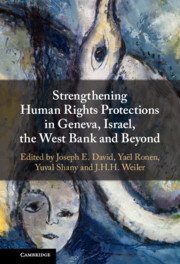Book contents
- Strengthening Human Rights Protections in Geneva, Israel, the West Bank and Beyond
- Strengthening Human Rights Protections in Geneva, Israel, the West Bank and Beyond
- Copyright page
- Contents
- Contributors
- Introduction
- 1 On Limits and Restrictions of Human Rights
- 2 Digital Surveillance, Meta Data and Foreign Intelligence Cooperation
- 3 Some Reflections upon Access to Justice, in the Transnational Setting, as a ‘Right to Law’
- 4 Human Rights Treaty Bodies as Standard-Setting Mechanisms
- 5 The Applicability of the Law of Occupation to UN Administration of Foreign Territory
- 6 The Responsibility of Businesses Operating in the Settlements in Occupied Territory
- 7 Occupational Hazards: Gender and the Law of Occupation in Israel-Palestine
- 8 Rule of Law De Jure and/or De Facto?
- 9 Political Liberalism in a Jewish and Democratic State
- 10 Law and Identity
- 11 David Kretzmer
- 12 David Kretzmer
- David Kretzmer: Selected Publications
- Index
4 - Human Rights Treaty Bodies as Standard-Setting Mechanisms
The Case of Family Law in CEDAW
Published online by Cambridge University Press: 13 August 2021
- Strengthening Human Rights Protections in Geneva, Israel, the West Bank and Beyond
- Strengthening Human Rights Protections in Geneva, Israel, the West Bank and Beyond
- Copyright page
- Contents
- Contributors
- Introduction
- 1 On Limits and Restrictions of Human Rights
- 2 Digital Surveillance, Meta Data and Foreign Intelligence Cooperation
- 3 Some Reflections upon Access to Justice, in the Transnational Setting, as a ‘Right to Law’
- 4 Human Rights Treaty Bodies as Standard-Setting Mechanisms
- 5 The Applicability of the Law of Occupation to UN Administration of Foreign Territory
- 6 The Responsibility of Businesses Operating in the Settlements in Occupied Territory
- 7 Occupational Hazards: Gender and the Law of Occupation in Israel-Palestine
- 8 Rule of Law De Jure and/or De Facto?
- 9 Political Liberalism in a Jewish and Democratic State
- 10 Law and Identity
- 11 David Kretzmer
- 12 David Kretzmer
- David Kretzmer: Selected Publications
- Index
Summary
This chapter introduces the evolution of a new field in family law – international human rights family law (IHRFL) – and traces the major role of one of the human rights treaty-monitoring bodies, the Committee on the Elimination of All Forms of Discrimination against Women (CEDAW Committee), in forming this field. In this new field, issues that have traditionally been thought of as solely part of the domestic legal order (i.e., under the jurisdiction and authority of each state) are now perceived to be part of international human rights law: protection from domestic violence; aspects of child custody; inheritance and property distribution upon dissolution of family relations. This means that family law should be understood as also governed by international human rights standards, whether they are hard law provisions in international treaties, or soft law jurisprudence of treaty bodies. States that have ratified the Convention on the Elimination of All Forms of Discrimination against Women (CEDAW) must scrutinise their family laws and bring them in line with the standards set by the CEDAW Committee in such matters as property relations, inheritance, protection from domestic violence and child custody. Through its standard setting function (i.e., the adoption of Concluding Observations, Views in Individual Communications, and General Recommendations), the CEDAW Committee is gradually and consistently contributing to the substantive development of IHRFL.
Keywords
- Type
- Chapter
- Information
- Publisher: Cambridge University PressPrint publication year: 2021
- 1
- Cited by

